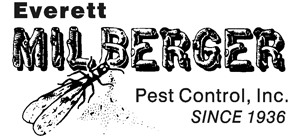The wolf spider is very common in Kansas City, Blue Springs, & Lee’s Summit, in fact, scientists have identified more than 125 species of wolf spider in the U.S. alone. Although many fear the wolf spider, in part, because of its large size, its bite is not truly deadly. However, some considered this spider to be one of the Top 10 Dangerous Spiders in the world,
Following are facts on identification: how to know if the spider you see is a wolf spider; location: where the wolf spider is found; behavior: its actions and its bite; and control: pest control – how to get rid of and prevent wolf spiders in your home.
Wolf Spider Identification
- The wolf spider is1/2 inch to 2 inches long, and hairy with orangeish-brown to grey and black camouflage coloring, with splotches or stripes of color.
- Its eight eyes are arranged in three rows of three different sizes, with 2 medium-sized eyes on top of its “head,” 2 large eyes center front, and four small eyes below those.
- Like all spiders, it has eight legs. But the wolf spider also has an additional two tiny leg- or arm-like appendages (pedipalps) extending out front.
- The young of this species look much the same as the adults, although the coloring may vary or change as they grow.
- Mothers may sometimes be seen with the young riding on their backs until these spiders are independent enough to go off on their own.
Where the Wolf Spider is Found
- Wolf spiders may live just about anywhere that insects can be found on which to feed.
- They are most likely to be found on the ground in open areas, such as farm fields and grassy areas or harboring in ground tunnels, between firewood, under leaf litter or other ground clutter
- In some areas, it can be a very common pest in the fall when it is seeking shelter”> against the cooling temperatures.
- In the home, they are most likely to be found around doors, windows, house plants, basements, and garages.
What the Wolf Spider Does
- This spider may also be called the ground spider or the hunting spider … primarily because it does just that: hunts on the ground.
- In fact, the wolf spider does not build webs to capture its prey, but goes out at night to hunt it down.
- It can climb and swim, but rarely does unless hunting prey.
- When disturbed, this spider will retreat and can move very quickly.
- Because it does not build webs, the female wolf spider will keep its eggs with it or bury it in its tunnel.
- Despite its name, the wolf spider does not live in packs. Rather it is a solitary creature, preferring to live and hunt alone.
- Unlike the orb-weaver spider, which operates primarily by feel alone, the wolf spider uses its vision to communicate. When one spider waves its front legs in certain ways to another wolf spider, it knows exactly what is meant.
The Bite of the Wolf Spider – And Treatment
- Although its bite is not deadly, it can be very painful.
- Some people may also be allergic to the bite of this – or any – spider, so you should always seek the attention/treatment by a doctor anytime you are bitten.
Pest Control – the Wolf Spider
- Spiders must be directly contacted through physical or chemical means.
- Because this is a solitary spider that generally operates alone, physical removal and/or kill of the individual spider can be the best form of control for both immediate and long-term results.
- To help exclude spiders from entering the home, seal cracks, crevices, gaps and other openings in the home structure, foundation, and around doors and windows.
- In addition to environmental and structural modifications and sanitation to reduce the potential for the spiders to harbor, the Washington State University Extension Service recommends pesticide use to include:
- Interior: an aerosol bomb or fogger to reduce existing spiders. This, however, “will not provide residual control for insect coming in later. The pesticide also may not penetrate inaccessible areas.”
- Exterior: “Cyfluthrin, bifenthrin, permethrin, tetramethrin or deltamethrin can be applied around the outside of doors, window, vents, outdoor stairwells or window wells, foundations, or cracks and openings. Spray only where needed.”
- When using any pesticide, follow label directions; be sure that the site, (indoor use, along foundations outside, etc.) is listed on the label; use only product labeled for spiders or nuisance pests.
- Contact a pest control professional who may use or recommend a variety of chemical ornon-chemical control methods in an Integrated Management Program (IPM).
Posted in General
